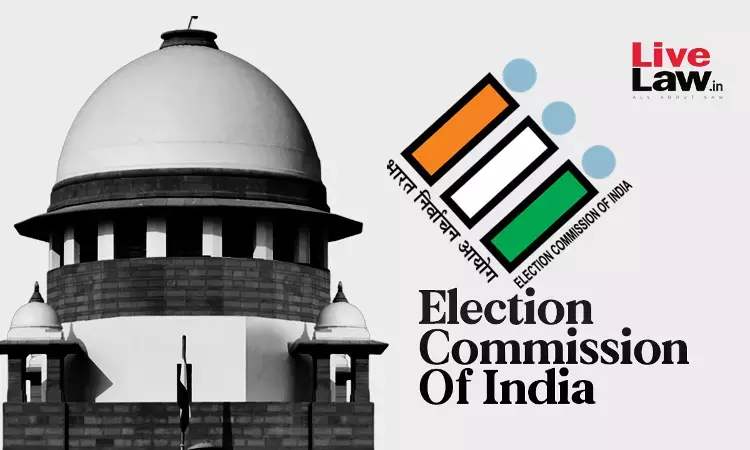- Home
- /
- Top Stories
- /
- Supreme Court Directs Election...
Supreme Court Directs Election Commission To Preserve CCTV Recordings Of Pollings In Plea Challenging Increase Of Voters Per Booth
Anmol Kaur Bawa
31 Jan 2025 7:46 AM
The Supreme Court today (January 31) directed the Election Commission of India to ensure that video recordings of the polling are not erased during the pendency of the challenge to ECI's decision to increase the number of voters per polling station. The bench of CJI Sanjiv Khanna and Justice Sanjay Kumar was hearing the PIL challenging the Election Commission of India's communication(s)...
The Supreme Court today (January 31) directed the Election Commission of India to ensure that video recordings of the polling are not erased during the pendency of the challenge to ECI's decision to increase the number of voters per polling station.
The bench of CJI Sanjiv Khanna and Justice Sanjay Kumar was hearing the PIL challenging the Election Commission of India's communication(s) whereby the maximum number of electors per polling station has been increased from 1200 to 1500.
Today, when the counsel for the ECI requested for additional time to file counter, the Court granted the request. The Court also directed the ECI to ensure that the video recordings of the polling are not erased during the pendency of the matter. The bench recorded the same in the order as follows :
"Counsel of Respondent 1 seeks more time to file the affidavit in compliance with the order dated 2.12.24, let the affidavit be filed within 3 weeks from today. Rejoinder if any shall be filed within 3 weeks after the service of the aforesaid... we find it appropriate to direct that the 1st Respondent shall maintain the CCTVs from which the videos are recorded as they were doing earlier"
Previously, CJI asked the ECI how the situation would be handled if more than 1500 people arrived at one polling station and sought an explanation from the ECI.
Notably, the bench on January 15 also sought a response from the Union in the Public Interest Litigation (PIL) filed by Rajya Sabha MP and Congress leader Jairam Ramesh challenging the recent amendment to the Conduct of Elections Rules 1961 on the ground that it prohibits the public disclosure of the CCTV footage of polling and other relevant records.
Background
The petition has been filed under Article 32 of the Constitution, challenging communications dated 07.08.2024 and 23.08.2024 issued by ECI, to the extent that the number of electors at each polling station in each constituency has been increased.
As per the petitioner, the decision to increase the number of electors per polling station is not supported by any data and has no rational nexus with the object sought to be achieved.
"Since 2011 there has been no census, and thus, the Election Commission has no fresh data to enhance the electors from 1200 to 1500...By increasing this limit, Respondent No.1 has compromised the operational efficiency of polling stations, potentially leading to longer waiting times, overcrowding, and voter fatigue," the plea reads.
Reference is made to Section 25 of the Representation of the People Act, which deals with provision of polling stations in constituencies.
“Sufficiency” of polling stations under the law, ought to mean sufficient to not cause structural barriers to voting and enabling the voting by marginalised groups. Further, Section 25 of the said Act, will have to be read in a manner that strengthens the democracy rather than resulting even in the possibility of exclusion of electors- especially since with the introduction of EVMs, the actual process of casting and counting the votes has become rather easy as compared to what it was in 1951", the plea states.
Further, the petitioner claims that it takes about 60-90 seconds for one elector to cast their vote. As elections are typically held for 11 hours, this means only 495-660 persons can vote per polling station. Considering the average voting percentage of 65.7%, it is perceivable that a polling station prepared to accept 1000 electors can accommodate about 650 voters. However, there are booths where elector turnout is in the range of 85-90%.
"In such a situation, about 20% of voters will either end up standing in queue beyond the voting hours or due to long waiting times will abandon exercising their right to vote. Neither is acceptable in a progressive republic or a democracy."
To accommodate this large number of voters, there must be a proportional expansion in polling booth infrastructure, the petitioner says.
It is also mentioned that in 2016, the ECI directed that the maximum number of electors assigned to a polling station be limited to 1,200 in rural areas and 1,400 in urban areas. Now, with the number being enhanced again, there is possibility of disenfranchisement.
"this practice of increasing the upper limit per polling station is nothing but Voter Disenfranchisement...This results in disparate impact on marginalised communities and low-income groups particularly daily wagers, rickshaw pullers, maids, drivers, vendors, etc. for whom long waiting hours result in deprivation of wages."
The petitioner prays that the ECI maintain the number of electors per polling booth as 1200 (as done from 1957-2016) and have sufficient number of polling stations in terms of the mandate of Section 25 of the RP Act. Additionally, a direction is sought for ECI to,
"progressively (that is for future) reduce the number of electors per polling station, by removing structural/institutional barriers to the exercise of the right to vote, having regard to the principle of non-retrogression".
Case Title: INDU PRAKASH SINGH VERSUS ELECTION COMMISSION OF INDIA AND ANR., Diary No. 49052-2024
Click Here To Read/Download Order

